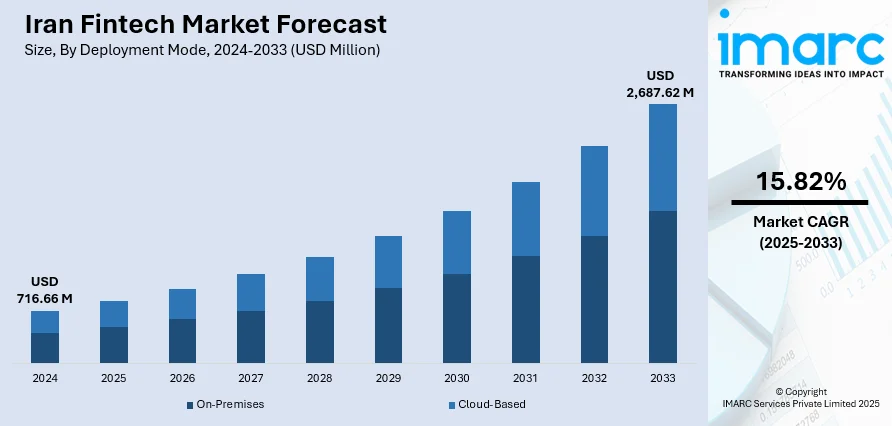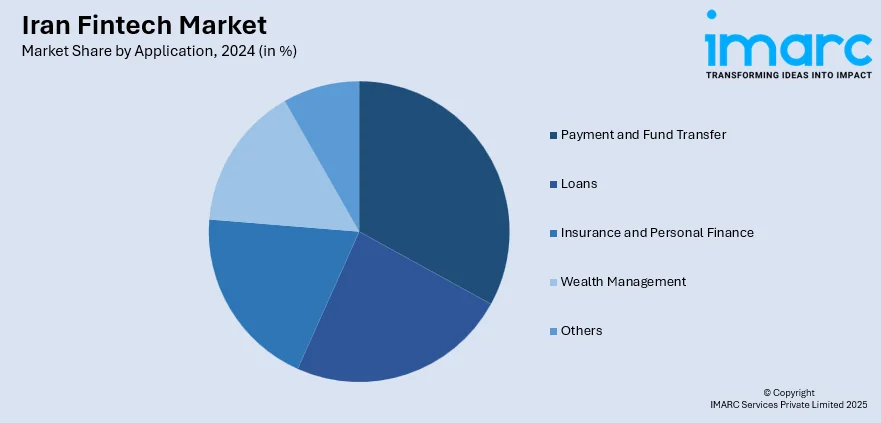
Iran Fintech Market Size, Share, Trends and Forecast by Deployment Mode, Technology, Application, End User, and Region, 2025-2033
Iran Fintech Market Overview:
The Iran fintech market size reached USD 716.66 Million in 2024. The market is projected to reach USD 2,687.62 Million by 2033, exhibiting a growth rate (CAGR) of 15.82% during 2025-2033. The market is undergoing significant growth, influenced by advancements in technology, changing user expectations, and a push toward digital financial services. Trends such as increased adoption of innovative applications, diverse deployment modes, and evolving end-user demands are shaping the competitive landscape. Fintech companies are leveraging emerging technologies to offer streamlined, customer-centric solutions across multiple sectors. With regional players adapting quickly and regulatory frameworks becoming more supportive, the sector is poised for continued evolution in both scale and complexity ultimately impacting the Iran fintech market share.
|
Report Attribute
|
Key Statistics
|
|---|---|
|
Base Year
|
2024
|
|
Forecast Years
|
2025-2033
|
|
Historical Years
|
2019-2024
|
| Market Size in 2024 | USD 716.66 Million |
| Market Forecast in 2033 | USD 2,687.62 Million |
| Market Growth Rate 2025-2033 | 15.82% |
Iran Fintech Market Trends:
Digital Payments Accelerate Nationwide
In Iran, digital payments are gradually becoming part of everyday life rather than a novelty. Recently, in May 2025, the Central Bank of Iran and Russia launched the second phase of integrating their payment systems, enabling mobile NFC payments for Russian bank cardholders in Iran. This move marks meaningful progress toward modernizing Iran’s payment infrastructure and aligns domestic practices more closely with international norms. Mobile wallets and digital payment apps are being adopted more widely even small vendors now accept QR‑based payments and customers are showing clear preference for seamless, tech‑enabled financial transactions. The adoption is not driven by hype but by everyday convenience: secure, fast, and easy to use. With improving smartphone penetration and digital literacy, many Iranians now find digital payments intuitive rather than intimidating. This growing comfort with digital tools hints at deeper shifts in how financial services are delivered and experienced. Overall, this development underscores critical Iran fintech market trends.

To get more information on this market, Request Sample
Digital Rial and Regional Payment Integration Gain Traction
Iran is making clear strides toward modernizing its financial infrastructure by introducing a central bank digital currency. In November 2024, the Central Bank announced that the Digital Rial is nearing launch a significant move toward a digital-first banking system. This update comes alongside deeper integration between Iran’s domestic Shetab payment network and Russia’s Mir system, with the link-up finalized. These steps are less about flashy headlines and more about building payment systems that are resilient, tech-forward, and adaptable even under sanctions. The Shetab network is already impressively fast and reliable, and the Digital Rial will overlay that strength with programmable, digital-native convenience. Together, these advancements reflect how Iran is quietly building smarter financial rails that can connect regionally and serve everyday users at home. It’s the kind of infrastructure work that doesn’t always grab headlines but lays the foundation for digital financial inclusion across urban and rural communities. This evolution signals a meaningful shift in how financial services are delivered a compelling sign of Iran fintech market growth.
Rise of Robust Digital Investment Tools
Amid economic shifts and growing digital savvy, Iranians are increasingly exploring investment through technology-driven platforms that feel approachable, not daunting. In June 2025, during the Iran–Israel conflict onset, the country experienced an internet blackout that led to a staggering drop-in online activity a moment that underlined just how central digital access has become to finance, including investment tools. But what’s stood out is how resilient digital investment platforms proved users returned quickly after such disruption to explore robo-advisor services, digital asset tools, and intuitive investment dashboards. It’s a testament to how these platforms are building trust: they’re easy to use, responsive, and can feel more trustworthy than traditional alternatives in uncertain times. With mobile access growing and experiences smoothing out, investing doesn’t require jargon or an expert it’s about building confidence one clicks at a time. This momentum in accessible, digital-first investment reflects a broader shift that’s quietly reshaping financial behavior. All in all, it’s another clear marker of Iran fintech market.
Iran Fintech Market Segmentation:
IMARC Group provides an analysis of the key trends in each segment of the market, along with forecasts at the country and regional levels for 2025-2033. Our report has categorized the market based on deployment mode, technology, application, and end user.
Deployment Mode Insights:
- On-Premises
- Cloud-Based
The report has provided a detailed breakup and analysis of the market based on the deployment mode. This includes on-premises and cloud-based.
Technology Insights:
- Application Programming Interface
- Artificial Intelligence
- Blockchain
- Robotic Process Automation
- Data Analytics
- Others
The report has provided a detailed breakup and analysis of the market based on the technology. This includes application programming interface, artificial intelligence, blockchain, robotic process automation, data analytics, and others.
Application Insights:

- Payment and Fund Transfer
- Loans
- Insurance and Personal Finance
- Wealth Management
- Others
A detailed breakup and analysis of the market based on the application has also been provided in the report. This includes payment and fund transfer, loans, insurance and personal finance, wealth management, and others.
End User Insights:
- Banking
- Insurance
- Securities
- Others
A detailed breakup and analysis of the market based on the end user has also been provided in the report. This includes banking, insurance, securities, and others.
Regional Insights:
- Tehran
- Khuzestan
- Bushehr
- Esfahan
- Khorasan
- Others
The report has also provided a comprehensive analysis of all the major regional markets, which include Tehran, Khuzestan, Bushehr, Esfahan, Khorasan, and others.
Competitive Landscape:
The market research report has also provided a comprehensive analysis of the competitive landscape. Competitive analysis such as market structure, key player positioning, top winning strategies, competitive dashboard, and company evaluation quadrant has been covered in the report. Also, detailed profiles of all major companies have been provided.
Iran Fintech Market News:
- June 2025: Nobitex, a leading Iranian digital trading platform, has begun resuming services following a disruptive security breach. The company initiated a controlled relaunch, restoring access to users’ wallets in phases, though full functionality including deposits and active transactions remains paused. Authorities have imposed restricted operating hours on local exchange services, as Nobitex works to rebuild trust and modernize infrastructure after the incident. This strategic effort underscores both the platform’s significance and the broader challenges facing Iran’s evolving digital financial landscape.
Iran Fintech Market Report Coverage:
| Report Features | Details |
|---|---|
| Base Year of the Analysis | 2024 |
| Historical Period | 2019-2024 |
| Forecast Period | 2025-2033 |
| Units | Million USD |
| Scope of the Report |
Exploration of Historical Trends and Market Outlook, Industry Catalysts and Challenges, Segment-Wise Historical and Future Market Assessment:
|
| Deployment Modes Covered | On-Premises, Cloud-Based |
| Technologies Covered | Application Programming Interface, Artificial Intelligence, Blockchain, Robotic Process Automation, Data Analytics, Others |
| Applications Covered | Payment and Fund Transfer, Loans, Insurance and Personal Finance, Wealth Management, Others |
| End Users Covered | Banking, Insurance, Securities, Others |
| Regions Covered | Tehran, Khuzestan, Bushehr, Esfahan, Khorasan, Others |
| Customization Scope | 10% Free Customization |
| Post-Sale Analyst Support | 10-12 Weeks |
| Delivery Format | PDF and Excel through Email (We can also provide the editable version of the report in PPT/Word format on special request) |
Key Questions Answered in This Report:
- How has the Iran fintech market performed so far and how will it perform in the coming years?
- What is the breakup of the Iran fintech market on the basis of deployment mode?
- What is the breakup of the Iran fintech market on the basis of technology?
- What is the breakup of the Iran fintech market on the basis of application?
- What is the breakup of the Iran fintech market on the basis of end user?
- What is the breakup of the Iran fintech market on the basis of region?
- What are the various stages in the value chain of the Iran fintech market?
- What are the key driving factors and challenges in the Iran fintech market?
- What is the structure of the Iran fintech market and who are the key players?
- What is the degree of competition in the Iran fintech market?
Key Benefits for Stakeholders:
- IMARC’s industry report offers a comprehensive quantitative analysis of various market segments, historical and current market trends, market forecasts, and dynamics of the Iran fintech market from 2019-2033.
- The research report provides the latest information on the market drivers, challenges, and opportunities in the Iran fintech market.
- Porter's five forces analysis assist stakeholders in assessing the impact of new entrants, competitive rivalry, supplier power, buyer power, and the threat of substitution. It helps stakeholders to analyze the level of competition within the Iran fintech industry and its attractiveness.
- Competitive landscape allows stakeholders to understand their competitive environment and provides an insight into the current positions of key players in the market.
Need more help?
- Speak to our experienced analysts for insights on the current market scenarios.
- Include additional segments and countries to customize the report as per your requirement.
- Gain an unparalleled competitive advantage in your domain by understanding how to utilize the report and positively impacting your operations and revenue.
- For further assistance, please connect with our analysts.
 Request Customization
Request Customization
 Speak to an Analyst
Speak to an Analyst
 Request Brochure
Request Brochure
 Inquire Before Buying
Inquire Before Buying




.webp)




.webp)












